Waking up with stiff, achy joints doesn’t have to dictate how the rest of your day unfolds. A targeted morning routine can transform those first difficult moments into smooth, comfortable movement that lasts from sunrise to bedtime.
This comprehensive approach addresses the root causes of morning joint stiffness through strategic movements, proper hydration, and temperature therapy. The sequence takes just 15 minutes but creates lasting effects that keep joints supple and pain-free throughout even the most demanding days.
Joint stiffness occurs naturally during sleep as synovial fluid thickens and muscles remain stationary for hours. The morning routine works by gently reactivating circulation, warming tissues, and encouraging proper fluid distribution throughout the joint spaces.
Understanding why joints stiffen overnight helps explain why this particular sequence proves so effective. During sleep, reduced movement allows inflammatory compounds to settle around joints while decreased circulation limits the delivery of nutrients needed for optimal joint function.
The wake-up water ritual
Before even getting out of bed, proper hydration begins the process of joint restoration. Drinking 16-20 ounces of room temperature water immediately upon waking helps thin synovial fluid and kickstart circulation throughout the body.
Adding a pinch of sea salt and fresh lemon juice to this morning water provides electrolytes that support proper fluid balance while the citrus offers natural anti-inflammatory compounds. This simple addition can significantly enhance the hydrating effects.
The timing of this hydration matters as much as the amount. Consuming water before coffee or other beverages ensures maximum absorption while the digestive system remains in its optimal state for fluid uptake.
Room temperature water moves through the system more efficiently than cold water, which can actually slow absorption and require energy to warm up internally. This temperature consideration makes a noticeable difference in how quickly the body responds.
Gentle bed stretches
While still lying down, a series of gentle stretches begins the joint mobilization process without placing weight-bearing stress on sensitive areas. These movements can be performed under warm blankets, maintaining body heat while encouraging circulation.
- Ankle circles performed slowly in both directions help mobilize the complex joint structures in the feet and lower legs. These movements pump fluid through the lower extremities and prepare the foundation for walking.
- Knee-to-chest pulls performed one leg at a time gently stretch the lower back and hip flexors while encouraging spinal mobility. Holding each stretch for 30 seconds allows tissues time to respond and lengthen.
- Gentle spinal twists performed by dropping knees to each side while keeping shoulders flat help mobilize the vertebrae and surrounding muscles. These twists should feel comfortable and never forced.
- Shoulder rolls and arm circles help mobilize the upper body joints that often feel particularly stiff after a night of limited movement. These motions can be performed lying down or sitting up on the edge of the bed.
The warmth activation phase
Temperature therapy plays a crucial role in joint comfort throughout the day. A warm shower immediately after bed stretches continues the warming process while the steam helps relax muscles and increase circulation.
Directing the shower water specifically onto stiff areas provides targeted heat therapy that can penetrate deeper into joint structures. Spending extra time allowing warm water to flow over shoulders, lower back, hips, and knees creates lasting comfort.
For those who prefer baths, adding Epsom salts provides magnesium that can be absorbed through the skin while the warm water continues the therapeutic process. A 10-minute soak can provide hours of improved mobility.
Alternating between warm and slightly cooler water for the last few minutes of the shower can help reduce any residual inflammation while maintaining the circulation benefits. This contrast therapy enhances the overall effectiveness.
Dynamic movement sequence
After warming with water therapy, gentle dynamic movements help transition joints from rest to full activity. These exercises should feel good and never cause pain or significant discomfort.
Standing forward folds with bent knees help stretch the entire posterior chain while encouraging blood flow to the brain. The bent-knee modification protects the lower back while still providing beneficial stretching.
Side bends performed slowly in each direction help mobilize the spine and stretch the muscles along the ribcage. These movements also help activate the core muscles that support proper posture throughout the day.
Gentle arm swings forward and backward help warm up the shoulder joints while encouraging full range of motion. These movements should be controlled and comfortable, never forced or painful.
Hip circles performed while standing help mobilize this important joint that connects the upper and lower body. Moving slowly through full circles in both directions helps distribute synovial fluid throughout the hip joint.
The inflammation-fighting breakfast
What you eat in the morning can significantly impact joint comfort throughout the day. Certain foods provide compounds that actively reduce inflammation while others can exacerbate stiffness and discomfort.
Anti-inflammatory foods for morning consumption include berries rich in antioxidants, fatty fish containing omega-3 fatty acids, and leafy greens packed with nutrients that support joint health. These foods work from the inside out to maintain comfort.
Spices like turmeric and ginger can be easily incorporated into morning smoothies or teas, providing potent anti-inflammatory compounds that accumulate in the system throughout the day. Fresh ginger tea with honey offers both comfort and therapeutic benefits.
Avoiding inflammatory foods in the morning helps prevent the cascade of inflammation that can lead to increased stiffness later in the day. Refined sugars, processed foods, and excessive caffeine can all contribute to joint discomfort.
Timing breakfast within an hour of waking helps stabilize blood sugar levels, which can influence inflammation throughout the body. Consistent meal timing also supports overall circadian rhythms that affect healing and recovery.
Posture preparation
How you position your body throughout the day significantly impacts joint comfort. Morning posture preparation sets the foundation for proper alignment during work, travel, and daily activities.
Wall angels performed against a flat wall help retrain proper shoulder and upper back positioning. Standing with back against the wall and slowly moving arms up and down like making snow angels helps activate the muscles needed for good posture.
Core activation exercises like gentle planks or modified bridges help strengthen the muscles that support proper spinal alignment. Even 30 seconds of gentle core engagement can provide hours of improved support.
Hip flexor stretches help counteract the effects of prolonged sitting that many people face during their workday. Stretching these muscles in the morning prevents them from tightening throughout the day.
Neck stretches in all directions help prepare for computer work or other activities that can strain cervical spine alignment. Gentle movements that feel good help maintain flexibility in this vulnerable area.
Mindful movement integration
The morning routine becomes most effective when movements are performed mindfully, paying attention to how each joint feels and responds. This awareness helps identify areas that need extra attention while preventing overexertion.
Breathing deeply during all movements helps deliver oxygen to tissues while activating the parasympathetic nervous system that supports healing and recovery. Each stretch should be accompanied by slow, controlled breathing.
Moving slowly allows tissues time to respond and adapt to the stretches. Rushing through the routine reduces effectiveness and may actually increase stiffness rather than relieving it.
Listening to body signals helps determine which movements feel most beneficial on any given day. The routine should be adaptable based on how joints feel each morning.
Environmental considerations
Room temperature affects how well joints respond to the morning routine. Cooler environments may require additional warming activities while excessively warm conditions might make some movements uncomfortable.
Clothing choices during the routine should allow for full range of motion without restriction. Loose, comfortable garments help maintain body heat while permitting complete movement patterns.
Lighting can influence mood and energy levels, which indirectly affect how well the body responds to movement. Natural light when possible, or bright artificial light, helps signal the body to fully wake up.
Music or calming sounds can enhance the experience while helping maintain proper timing for stretches and movements. Rhythmic breathing can be synchronized with background sounds for added benefit.
Long-term adaptation strategies
As joint health improves with consistent practice, the morning routine can be gradually expanded or modified to address specific problem areas. Flexibility in the approach ensures continued effectiveness over time.
Seasonal adjustments may be necessary as weather changes can affect joint stiffness. Colder months might require additional warming activities while summer routines can focus more on hydration and gentle movement.
Age-related changes in joint function may require modifications to the routine over time. The key principle remains the same: gentle, consistent movement that feels good and improves daily comfort.
Tracking daily comfort levels helps identify which elements of the routine provide the most benefit. This awareness allows for customization that maximizes results while minimizing time investment.
Creating lasting habits
Consistency proves more important than perfection when establishing this morning routine. Even abbreviated versions performed regularly provide more benefit than perfect routines done sporadically.
Preparing the night before by laying out comfortable clothes and ensuring easy access to water helps remove barriers to morning success. Small preparations make the routine more likely to become habitual.
Starting gradually with just a few elements and building the complete routine over time creates sustainable habits. Attempting too much too quickly often leads to abandoning the practice entirely.
Celebrating small improvements in daily comfort reinforces the value of the routine and encourages continued practice. Recognizing progress, even minor improvements, builds motivation for long-term success.
The morning joint stiffness elimination routine offers a practical, effective approach to all-day comfort through simple, natural methods. By addressing the root causes of morning stiffness with targeted hydration, gentle movement, and anti-inflammatory practices, this 15-minute investment creates lasting benefits that transform daily life. Consistency with these gentle practices provides cumulative benefits that improve not just morning comfort, but overall joint health and mobility for years to come.















